The BAREBOW! Chronicles: The Longbow Does It!
Dennis Dunn 05.30.14

September, 1997. It had been three years since Karen accompanied me and my two sons on a “family” big game hunt to Mackay Lake, courtesy of Gary and Bertha Jaeb of True North Safaris. When I discovered in the spring of 1997 that my younger son, Reagan, would be free to join me for another late-August/early-September bowhunt up there in the Northwest Territories, I called Gary right away and asked if he could possibly squeeze us into his Warburton Bay camp for the hunt that began around August 30. I had always wanted to try a hunt out of that smaller camp, because it was down near the western end of the big lake, with more islands nearby, and therefore there was less “big water” to worry about in windy weather. Gary said he had two slots left for that week, so we began looking forward with great anticipation to another action-packed bowhunt together. The summer could not pass fast enough.
On Reagan’s first caribou hunt in 1994, he had taken two Pope and Young bulls with his bow, the larger of which actually qualified for entry into the All-Time Boone and Crockett Records Book. Since Boone and Crockett, however, does not accept entries with the antlers in velvet, Reagan never entered his outstanding animal. He really wanted to have it mounted by a taxidermist in the velvet. Such mounts are truly beautiful, and can only be done that way if the animal is killed early in the season.
Within a three- to four-day period, usually during that first week of September, the bulls’ antlers all stop growing and the velvet starts to “itch” and drive them crazy. To get rid of this fuzzy sheathing, so that the sharp “swords” that make up their headgear will be ready to do battle during the impending rut, the bulls start beating their antlers against every little patch of willows or dwarf spruce trees they can locate out there in the vast barrenlands north of the main tree line. It is a great time to hunt them, because they are often so distracted by the violent thrashings they’re administering to the helpless vegetation that you can sneak right up on them. For every bull, each autumn, there’s always a day or two—with the velvet in tatters, half-off and half-on—when he looks as if he’s just run through a pasta kitchen and been dueling with a huge pot of fettuccini marinara.
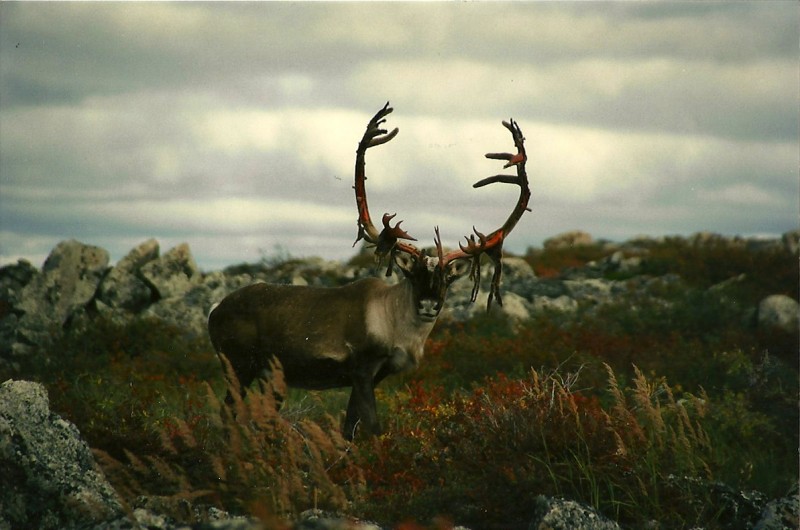
The success I’d had with my recurve bow near the end of my 1996 hunt at Mackay Lake had gotten me excited enough that I decided to do my next hunt with a straight longbow. I knew I was really going to enjoy getting back into traditional archery, and consequently, later that fall, I placed an order with Jay St. Charles for a custom, take-down longbow designed to draw 56 pounds at my draw-length. Jay finished it and autographed it for me with a date of January 20, 1997.
As September approached, I became more and more excited about the idea of taking a big caribou with my longbow. Despite three previous hunts at Mackay Lake, I still had not taken a caribou I could enter into the Pope and Young Records. Thus the idea of finally doing so with a St. Charles longbow really had me pumped up more and more each day as the date for our drive north drew near. By then I had developed a good deal more confidence in the weapon, and in my ability to shoot it accurately.
Reagan and I had decided that we would only buy one tag apiece, but that we would really make it count by turning down every opportunity to shoot at anything less than a “book” animal. If the hunting proved again as good as it had been in the past, then we would both have plenty of chances to be quite selective in how we filled our tags. That was the plan, at least, and I must say it worked to a tee. Everything considered, this hunt ended up being one of the most satisfying I’ve ever experienced.
When the floatplane set us down on Warburton Bay on August 31, the water was calm, the weather perfect. Caribou were moving around pretty much everywhere you looked, and things didn’t change much for the next seven days! A cluster of four or five, small, brightly-colored cabins stood on the hill just above the dock, and within 30 minutes Reagan and I had all our gear stowed within the cozy confines of the pink one.
Having been airborne that afternoon, we could not hunt legally till the next morning. As a result, when our guide, Bobby Migwi, told us about a creek that emptied into the bay just a half-mile from camp, we borrowed a spinning rod and went off to catch something fresh for dinner. A 19-inch Arctic grayling readily obliged us. After a hearty breakfast the next morning, we prepared our packs for the day and met Bobby down on the dock. Our lunches and a 16-foot aluminum boat filled with gas awaited us, and the hunt was on!
Throughout that first day, time after time, as we cruised around the many islands that choked up that end of the big lake, we would spot some good bulls near the shore, travel on beyond them out of sight, then land the boat and try to make a stalk. Nothing ever quite seemed to work out. Either the fickle breeze would change, or the caribou’s direction of travel, or we’d get “busted” visually, once we ran out of cover. I guess that’s largely the nature of bowhunting, anyway. You never control all the cards in the deck, and often your quarry holds most of the trump.
As we were heading back toward camp that first evening in the boat, we spotted two very nice bulls feeding on this one medium-sized island. After glassing them for a bit and deciding they were definitely worth the effort, we continued on around the point and put ashore for a stalk. One of the bulls appeared gimpy for some reason, and Reagan voiced a preference for going after that one. With tongue in cheek, I told him I preferred the greater challenge of going after the healthier one, so—with a light heart and high hopes—we grabbed our bows and set out in two slightly different directions for the final stalk of the day. Unfortunately, 50 yards was about the closest I ever got to my bull, because he kept feeding and traveling away from me.
As for Reagan, he eventually crawled to within 45 yards of his bull, but then a change in the wind did him in, and the “cripple” suddenly bolted out of sight as though he’d been a sprinter in training all summer long. It was, in summary, just another one of those glorious days of maybes, almosts, what ifs, and should-have-beens that are so special in the nostalgic memory bank of every experienced bowhunter.
First thing next morning, we returned to the same island where we’d made our final stalk the night before. It didn’t take long to find Reagan’s gimpy bull. The wind was now perfectly in our favor. After sneaking the boat into a secluded cove, we relocated him feeding in our direction. Reagan and I took up positions about 80 yards apart in some decent cover, and sent Bobby way around in a big loop to get on the upwind side of our quarry.
About the time we started seeing Bobby’s head “bobbing” along above the brush, coming our way, the big caribou snapped his head up, sniffed the air, and began moving in our direction as well. When the animal had reached a point just 25 yards from my son, and broadside, he paused for a moment, then continued on. Reagan’s release of the arrow took place just as the bull resumed his forward motion, and the arrow struck him at the base of the hip, rather than in the rib cage at which it had been aimed. Increasing his pace to a trot, the animal seemed only vaguely aware that something was wrong as he headed toward the lakeshore. Forty yards along his path, the arrow fell to the ground—tugged at by some sturdy willow branches. Perhaps 300 yards from the ambush spot, Reagan’s bull bedded on the edge of the lake, while the three of us sat down at a distance on a little knob to keep an eye on him and discuss the situation.
The accumulating evidence appeared substantial that the arrow had severed the femoral artery in the caribou’s right hip. When viewed through our binoculars, a long patch of crimson was showing there, and it was expanding steadily. Along the path he had taken to the lake, our glassing turned up numerous little spots of scarlet on the green mosses or whitish lichens. Reagan was absolutely convinced he’d struck that main artery in the rear leg, and Bobby seemed to feel pretty certain of it also. We all knew that—if such were the case—the animal was probably feeling very little discomfort, but would simply get weaker and weaker until finally slipping below the Lethean waters of permanent oblivion.
The only problem with that kind of hit on an animal is that it sometimes takes an hour or more before death arrives. No hunter wants it that way, but it is an infinitely better way for the creature to go than to be eaten literally alive by the kind of predator that kills with fangs. There is not one predator in all of Nature’s food chain—except man—who cares one whit about killing quickly, cleanly, or mercifully. The magnificent bull Reagan had arrowed might live for another hour or so, but his life would ebb away silently and painlessly—for the simple fact that bleeding is not sentient for man or beast. We simply don’t feel it happening.
Three-quarters of an hour passed, as we waited for nature to run its course. Suddenly, to our surprise, the stricken bull rose from his bed, walked down to the water’s edge, waded in, and began swimming out to a tiny island about 70 yards off shore. Perhaps he was sensing that the end was near. Once on the island, he lay down again, while Reagan—rather alarmed that his trophy caribou might be about to escape—ran down to the lakeshore to see if he couldn’t finish him off with a second arrow. Seeing Reagan approaching, the bull rose again, and, as Reagan tried a long-distance shot in desperation, he slipped into the water a second time and began swimming to only-he-knew-where. The arrow shaft sailed harmlessly over the animal’s back, disappearing beneath the waves.
Where we had parked the boat a couple hours earlier was not far from the little island, so Bobby and I hastened to join up with Reagan, and the three of us quickly jumped into the boat and shoved off. If, indeed, as we suspected, the bull was now nearly bled out from the hit on the femoral artery, our great fear was that he might suddenly expire in the middle of his swim-to-nowhere and then sink to the bottom of the lake!
Within a minute of being waterborne ourselves, we noticed the bull was starting to flounder. He was a good 100 yards from us and from shore, so when— seconds later—all motion ceased, a collective gasp could be heard emanating from our boat. How long he might stay floating, none of us knew, but we did know we wanted to get a rope around his antlers asap! As things turned out, he was still floating quite nicely when we reached him, and towing him ashore was a piece of cake.
Once we finally got the big, records-class bull hauled up on the bank, where the field-dressing could begin, it was time for the three Hs: handshakes, high-fives, and hugs! I think Reagan was as excited and pumped up as I’ve ever seen him, before or since. Following the 60-day drying period, his bull officially scored 351 7/8. At that time, the minimum for the species for listing in the All-Time Boone and Crockett Records was 345. Today the minimum is 360, but in either case it was Reagan’s second B&C caribou in the span of three years.
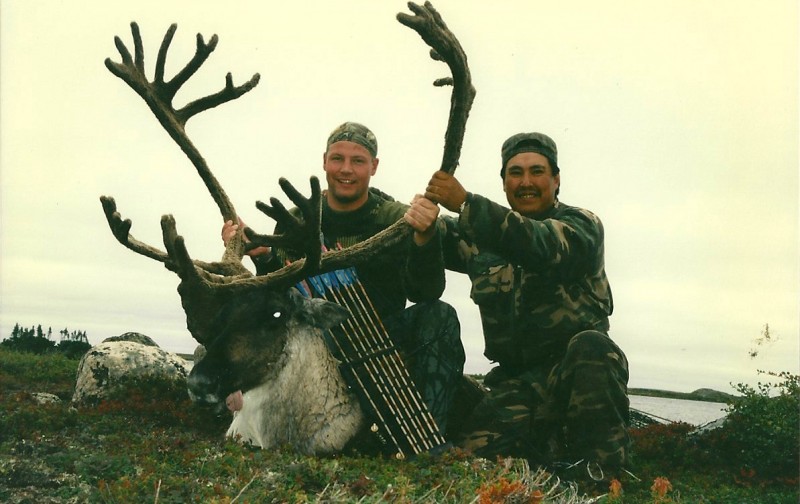
My victory on this hunt, however, was yet to come, although not until the last day. Days three, four, and five witnessed several exciting stalks on my part, but nothing quite seemed to work out the way it was supposed to. Murphy’s Law appeared to be the order of all three days. I shall never forget, however, that on day four I was able to photograph at exceedingly close range, from within the safe confines of our boat, a tundra grizzly. This is the scarce barren ground variety which SCI classifies as a separate game category. They live only north of the tree line and are especially known for being nasty.
We happened to catch him crossing a channel between two islands. Swimming as he was, without his feet on the bottom, he could only snarl at us and give us the evil eye as we made slow, tight circles around him. I shall never forget the “OH, S___!” look on his face when we first drew up alongside. It was priceless!
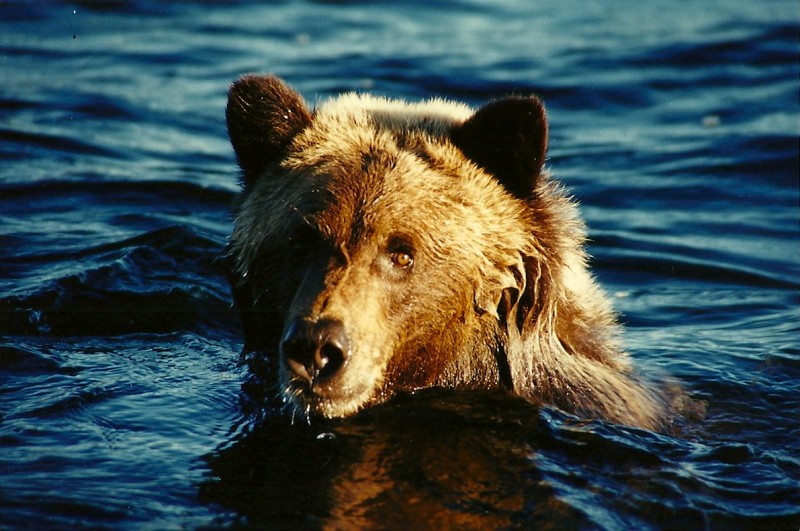
Day six was my lucky day. On the way back to camp the night before, we had passed close by a fairly small island and seen three large bulls together along this one particular shoreline. In the rich, golden light of evening, with the sun at our backs, one bull stood out above the rest—even before he rose from his bed to get a better squint at us right into the sinking sun. Unlike the other two, his antlers were completely stripped of velvet and seemed unusually yellow in color.
And his mane! His mane was just incredible! The front of his shoulders, brisket, and full neck were as perfectly white as fresh-fallen snow! For a bull so early in the fall, I could hardly believe my eyes. Normally, as the fall progresses and winter comes on, a bull caribou’s mane grows significantly longer and whiter. This particular bull was already sporting the biggest, whitest mane I think I’ve ever seen—for any species of caribou, in any season of the year.
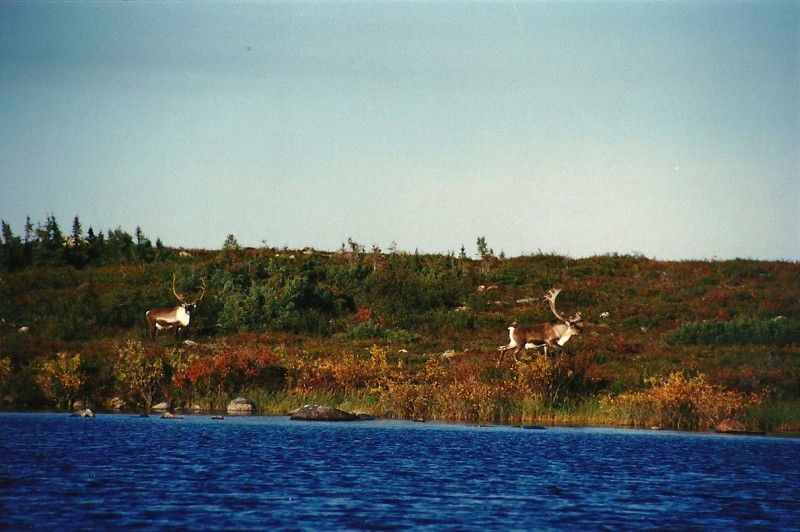
I thought about him much that night in our cabin. Even his two buddies would score well over the P&Y minimums, I felt certain. Would the threesome still be on that same island, come morning? Could we find them again? If not on that island, maybe on a neighboring island?
Following a good night’s sleep and another hearty breakfast, I knew the answers would be waiting for us in short order. Indeed, they were. And so were the bulls!
Not more than a quarter-mile from where we’d last seen them, we found them again, though they’d been joined overnight by some cows and calves. After studying the direction of the prevailing winds, Bobby decided I should take a stand at the downwind tip of the island. He and Reagan dropped me off there and then proceeded by boat around the other side of the island to the far end, from which they would begin their drive on foot.
My tip of the island had quite a sharp point to it, with a well-worn game-trail coming right to the water’s edge only 15 yards from a short hedgerow of little spruces. By standing in six inches of water, I found the trees would provide me with perfect cover for an ambush. Once in position, I had only to wait for the caribou to see (or catch wind of) the other members of my wolf-pack. It is a successful hunting technique used the world over by predators of all kinds.
I had not been standing in the water for long when the bushes up-island started moving. Immediately, the gray-brown colors of the “women and children” were coming my way at breakneck speed. Right behind was one of the bulls, yet I was unable to spot either of the other two behind him. Had they chosen to depart the island in a different direction? No matter, I thought to myself. This one trotting right behind the cows and calves was all the bull I needed. Nearly always, when a caribou is about to enter the water, it will pause—at least momentarily—before getting its first foot wet. The cows and calves did just that before plunging in, and, when the bull started applying the brakes as he neared the end of the waiting line, I started drawing my arrow, aiming as I drew. As soon as my string-fingers touched my chin, the arrow was away.
Thunk! A solid hit! In fact, as the whole crew exploded off the bank and began swimming toward the next island 100 yards distant, I could see the turkey feathers of my wooden arrow just protruding from the center of the bull’s rib cage. A perfect double-lung shot, I noted, congratulating myself. It was only then that I glanced down the trail they’d all just arrived by and saw the other two bulls trotting my way. The huge bull with the yellow antlers was, indeed, bringing up the rear. At close range, as he slipped into the lake, he looked even more awesome than I had imagined he would.
My trophy bull, nonetheless, proved more than enough to send me home happy. My one worry, as I watched him swimming off toward the next island, was whether he could even reach it before expiring. He did, in fact, get there—but just barely! Once Bobby and Reagan brought the boat around to pick me up, we all hurried across the water to look for my trophy ‘bou. As we arrived at the precise spot where the animals had made “landfall” on the second island, we discovered that my bull had given that word new meaning. He had apparently died on his feet as he exited the water, and fallen on the first patch of land he could reach. The water was crimson for 15 feet out from the shore, and we found his lifeless body lying in a clump of bushes only five feet from the edge of the lapping waves.
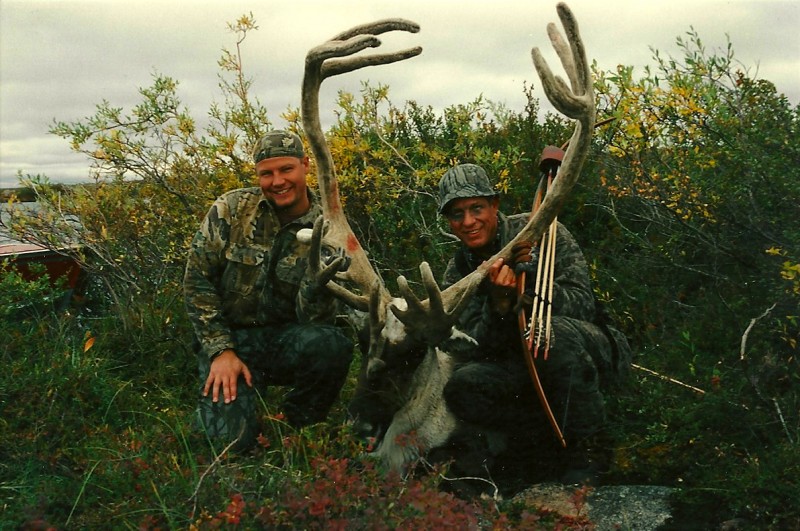
What a great experience this hunt had been with my younger son! In reviewing the video of it, I’m reminded that he seemed every bit as genuinely excited about my kill as he had been about his own. (And vice versa!) I had taken his older brother, Bryant, in the spring of that same year, on a successful bear hunt in Saskatchewan. Both hunts had helped to “pour oil on troubled waters,” and I am a strong proponent of the view that few things in the world can create more bonding between family members than simply spending time together in the Great Outdoors.
This 1997 caribou hunt with Reagan was also very special for me, due to another, far less important reason. It allowed me finally to notch my first Central Canada Barren Ground Caribou of records-book quality, and I had done it with a longbow! An old friend named Rusty Watson, long-since moved from Washington to Montana, had made the wooden arrow for me, and another—Jay St.Charles—had made the yew wood bow. I want to thank them both for fashioning by hand the superb archery equipment which allowed me to fulfill one more of my many dreams.
Editor’s note: This article is the twenty-fourth of the BAREBOW! Chronicles, a series of shortened stories from accomplished hunter and author Dennis Dunn’s award-winning book, BAREBOW! An Archer’s Fair-Chase Taking of North America’s Big-Game 29. Dunn was the first to harvest each of the 29 traditionally recognized native North American big game species barebow: using only “a bow, a string, an arrow—no trigger, no peep sights, no pins—just fingers, guts, and instinct.” Each of the narratives will cover the (not always successful, but certainly educational and entertaining) pursuit of one of the 29 animals. One new adventure will be published every two weeks—join us on the hunt! You can learn more about the work and purchase a copy on Dunn’s site here. Read the twenty-third Chronicle here.
Top image by Dennis Dunn

